Mononychellus tanajoa (cassava green mite)
Identity
- Preferred Scientific Name
- Mononychellus tanajoa Bondar
- Preferred Common Name
- cassava green mite
- Other Scientific Names
- Mononychus tanajoa Fletchman & Baker, 1970
- Tetranychus tanajoa Bondar
- International Common Names
- Englishcassava green mite
- Spanishacaro amarillo de la yuccaacaro verde de la yucca
- Frenchacarien vert
- Local Common Names
- Brazilacaro verde da mandioca
- East Africautitiri wa muhogo
- EPPO code
- MONNTA (Mononychellus tanajoa)
Pictures
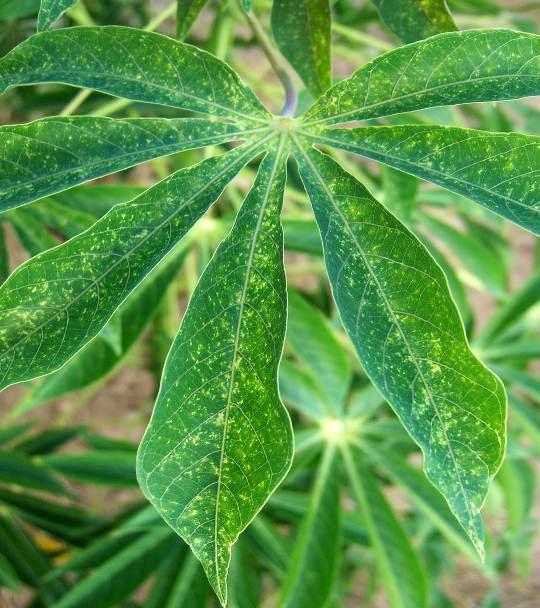
Mononychellus tanajoa
Symptoms on cassava leaves
CABI
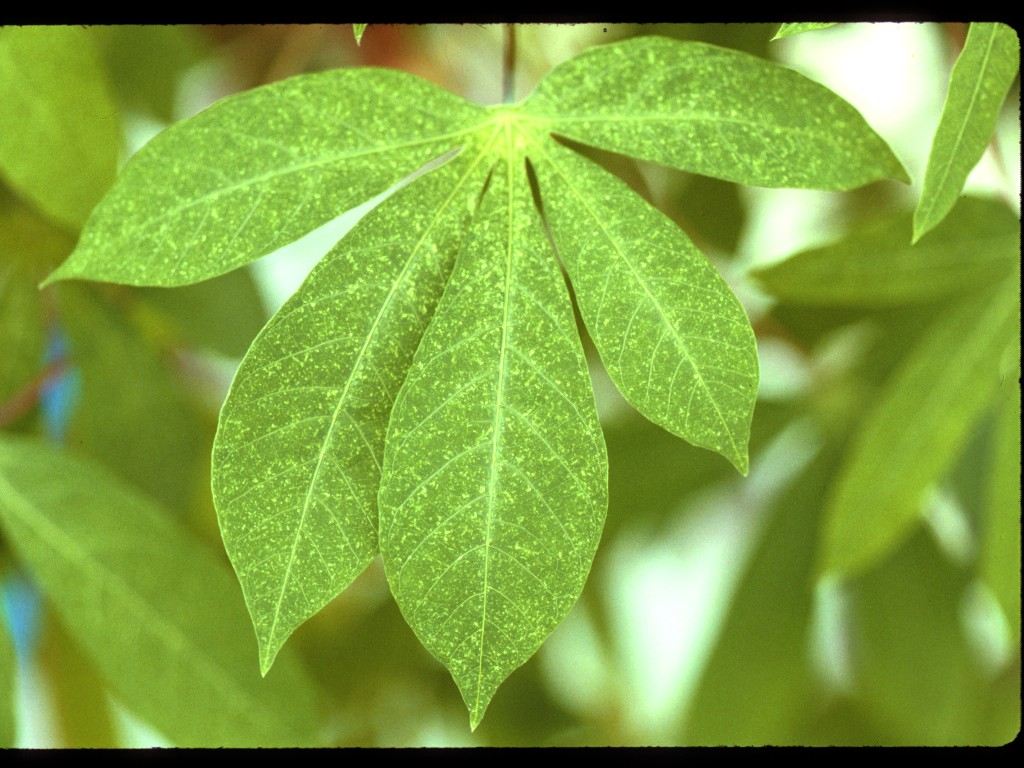
Effects of Mononychellus tanajoa (Cassava mites).
Cassava leaf with chlorotic (pale) spots caused by cassava mites.
International Institute of Tropical Agriculture
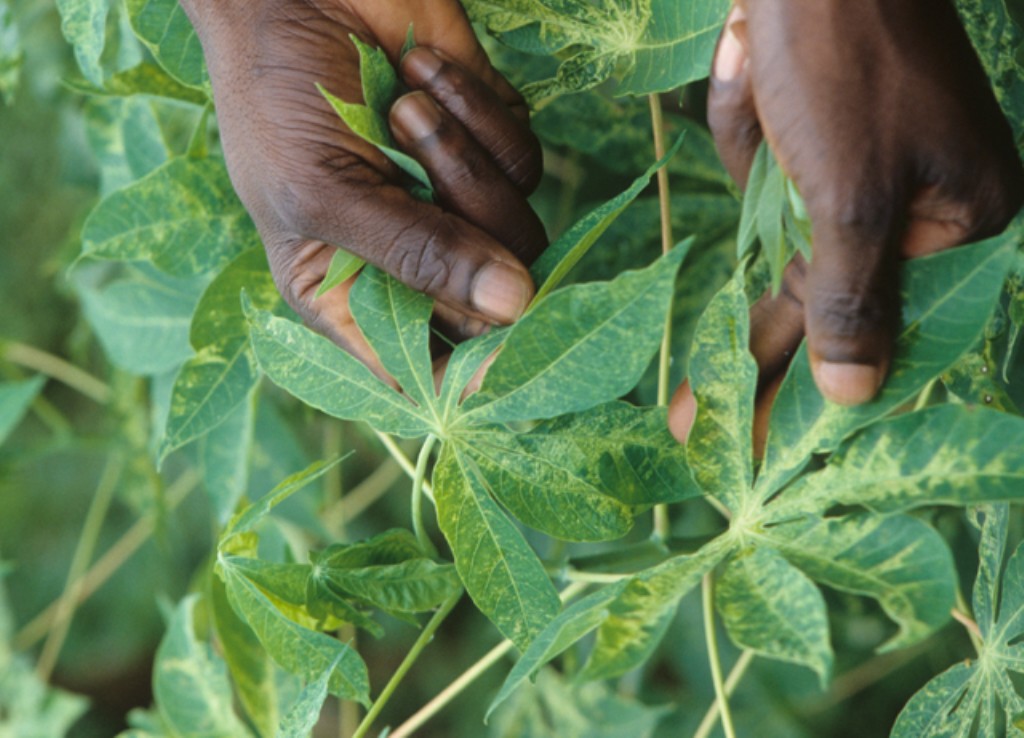
Effects of Mononychellus tanajoa (Cassava mites).
Researcher inspecting cassava leaves infested by cassava mites.
International Institute of Tropical Agriculture
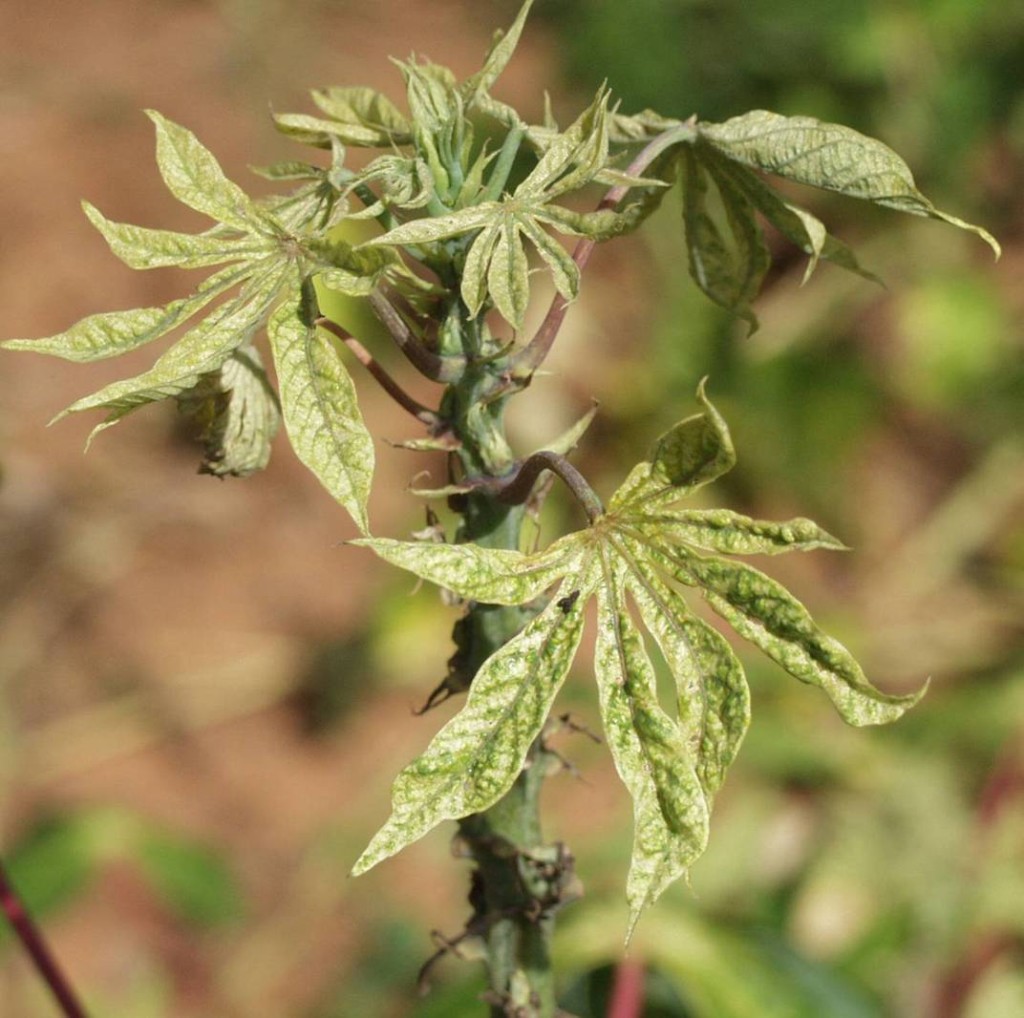
Effects of Mononychellus tanajoa (Cassava mites).
Cassava leaves with chlorotic (pale) spots caused by cassava mites.
International Institute of Tropical Agriculture
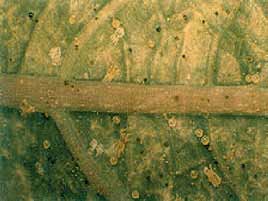
Mononychellus tanajoa
Cassava green mite eggs and active stages
Coleacp
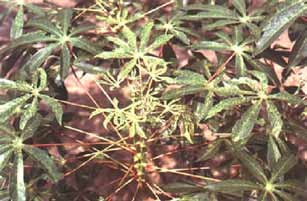
Mononychellus tanajoa
Yellow spots on leaves
Coleacp
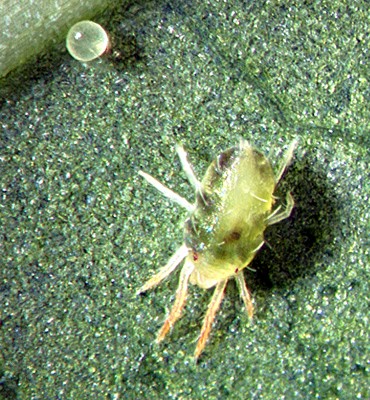
Adult
Adult female mite with egg. Adult females are bigger than the males and attain a size of 0.8 mm.
©Georg Goergen/IITA Insect Museum, Cotonou, Benin
Distribution
Host Plants and Other Plants Affected
| Host | Host status | References |
|---|---|---|
| Manihot esculenta (cassava) | Main |
Symptoms
M. tanajoa usually feed on the underside of young leaves, by inserting their piercing and sucking mouthparts (chelicerae) into individual cells and extracting the cell contents. This causes chlorosis as the chlorophyll is sucked from the cells. The leaves may become mottled, die and abscise. Severe attack leads to death and shedding of terminal shoots leading to the characteristic 'candle stick' symptom.
List of Symptoms/Signs
| Symptom or sign | Life stages | Sign or diagnosis |
|---|---|---|
| Plants/Leaves/abnormal colours | ||
| Plants/Leaves/abnormal leaf fall |
Prevention and Control
Regulatory Control
Close inspection of cutting materials and the use of clean certified cuttings may reduce the spread of M. tanajoa and delay the time of infestation of the cassava crop.
Cultural Control
Cultural control is limited owing to economic, technical and social constraints. Options include early planting at the onset of the rains to encourage vigorous growth and thereby increase tolerance to mite attack. Cassava plants aged 2-9 months are the most vulnerable to infestation.
The way a mite-infested cutting is planted influences the presence of the mites on the leaves soon after sprouting. Cuttings planted in a slanting position had mites on the leaves soon after sprouting, but those planted horizontally did not (Ezulike and Egwuatu, 1990). Ezulike and Egwuatu (1993b) reported that cassava intercropped with pigeon pea suffered less damage from M. tanajoa than that grown on a pure stand. They also found that cassava intercropped with pigeon pea in triple and double rows gave higher tuber yields than when it was alternated in a single row or in a pure stand.
Host-Plant Resistance
Certain attributes, such as leaf pubescence (Leuschner, 1982), have been claimed to confer tolerance to M. tanajoa. Some attempts have been made to identify mite-resistant cassava cultivars (Shukla, 1976; Santos et al., 1977; Byrne et al., 1982a,b; Markham and Robertson, 1987; Msabaha, 1984) but further studies including damage symptoms, tuber yields and disease resistance of the selected cultivars need to be carried out. Immunity to M. tanajoa is not known.
Biological Control
The importation of phytoseiids from the neotropics (especially from Colombia and Brazil) and their release into Africa began in 1984. In 1991, Amblyseius (=Neoseiulus) idaeus from north-eastern Brazil was reported to have persisted for over 18 months after release in Benin (Yaninek et al., 1991).
Toko et al. (1996) released the predator Amblyseius manihoti into a cassava field infested with M. tanajoa at the beginning of the dry season and recorded a 20% decrease in the numbers of M. tanajoa compared with control areas where there were no predators.
Herrera et al. (1994) studied the population dynamics of M. tanajoa and its predators Amblyseius limonicus and A. idaeus on cassava at three sites in Colombia between 1988 and 1990. The numbers of the phytoseiids increased in response to the population growth of M. tanajoa, but higher predator densities were observed when M. tanajoa densities were low. At one site (Pivijay), A. limonicus appeared at the peak population of M. tanajoa and suppressed the pest population, while itself persisting during the wet season in the absence of M. tanajoa. Compared with plots without predators, cassava plots with predators harboured less than 50% of the M. tanajoa population and produced double the fresh tuber yields.
The mite Typhlodromalus manihoti has been established in West Africa since its importation in 1989 from north-eastern Brazil (which is ecologically more similar to sub-Saharan Africa than is Colombia).
Typhlodromalus aripo was introduced from Brazil into West Africa to control M. tanajoa in 1993 (IITA, 1996). T. aripo has now spread, at times at a rate of 200 km/year, and established itself in more than 11 countries in Africa. M. tanajoa populations have dropped to less than 20/leaf, from more than 40/leaf before the introduction of T. aripo. Post release surveys conducted under farm field conditions in Tanzania reported a decline of M. tanajoa population densities from > 200 mites per leaf (before T. aripo introduction) to < 20 mites per leaf (Pallangyo et al., 2004). During a predator exclusion experiment, M. tanajoa population densities and damage severity were reduced by 64.3% and 45.3% respectively leading to an increase in cassava yield by up to 70% (Pallangyo et al., 2004). In Benin, this has led to a 30% increase in tuber yields, equivalent to a gain of $3 million per season.
The predatory insects Stethorus spp. and Holobus (=Oligota) spp. have been reared and released in a number of countries.
Among the pathogens, Neozygites spp. have shown the greatest potential for biological control. It has been reported to cause mortalities among M. tanajoa populations in Venezuela (Agudelo-Silva, 1986), Brazil (Delalibera et al., 1992), Colombia (Alvarez et al., 1993), Benin (Yaninek et al., 1996) and Kenya (Bartowski et al., 1988). The effect of abiotic factors on the ability of this fungus to cause epizootics among populations of M. tanajoa has been studied by Oduor et al. (1995a, b; 1996a, b; 1997a, b). Brazilian species are being compared with African strains to identify the ideal isolate for mass release in Africa.
Close inspection of cutting materials and the use of clean certified cuttings may reduce the spread of M. tanajoa and delay the time of infestation of the cassava crop.
Cultural Control
Cultural control is limited owing to economic, technical and social constraints. Options include early planting at the onset of the rains to encourage vigorous growth and thereby increase tolerance to mite attack. Cassava plants aged 2-9 months are the most vulnerable to infestation.
The way a mite-infested cutting is planted influences the presence of the mites on the leaves soon after sprouting. Cuttings planted in a slanting position had mites on the leaves soon after sprouting, but those planted horizontally did not (Ezulike and Egwuatu, 1990). Ezulike and Egwuatu (1993b) reported that cassava intercropped with pigeon pea suffered less damage from M. tanajoa than that grown on a pure stand. They also found that cassava intercropped with pigeon pea in triple and double rows gave higher tuber yields than when it was alternated in a single row or in a pure stand.
Host-Plant Resistance
Certain attributes, such as leaf pubescence (Leuschner, 1982), have been claimed to confer tolerance to M. tanajoa. Some attempts have been made to identify mite-resistant cassava cultivars (Shukla, 1976; Santos et al., 1977; Byrne et al., 1982a,b; Markham and Robertson, 1987; Msabaha, 1984) but further studies including damage symptoms, tuber yields and disease resistance of the selected cultivars need to be carried out. Immunity to M. tanajoa is not known.
Biological Control
The importation of phytoseiids from the neotropics (especially from Colombia and Brazil) and their release into Africa began in 1984. In 1991, Amblyseius (=Neoseiulus) idaeus from north-eastern Brazil was reported to have persisted for over 18 months after release in Benin (Yaninek et al., 1991).
Toko et al. (1996) released the predator Amblyseius manihoti into a cassava field infested with M. tanajoa at the beginning of the dry season and recorded a 20% decrease in the numbers of M. tanajoa compared with control areas where there were no predators.
Herrera et al. (1994) studied the population dynamics of M. tanajoa and its predators Amblyseius limonicus and A. idaeus on cassava at three sites in Colombia between 1988 and 1990. The numbers of the phytoseiids increased in response to the population growth of M. tanajoa, but higher predator densities were observed when M. tanajoa densities were low. At one site (Pivijay), A. limonicus appeared at the peak population of M. tanajoa and suppressed the pest population, while itself persisting during the wet season in the absence of M. tanajoa. Compared with plots without predators, cassava plots with predators harboured less than 50% of the M. tanajoa population and produced double the fresh tuber yields.
The mite Typhlodromalus manihoti has been established in West Africa since its importation in 1989 from north-eastern Brazil (which is ecologically more similar to sub-Saharan Africa than is Colombia).
Typhlodromalus aripo was introduced from Brazil into West Africa to control M. tanajoa in 1993 (IITA, 1996). T. aripo has now spread, at times at a rate of 200 km/year, and established itself in more than 11 countries in Africa. M. tanajoa populations have dropped to less than 20/leaf, from more than 40/leaf before the introduction of T. aripo. Post release surveys conducted under farm field conditions in Tanzania reported a decline of M. tanajoa population densities from > 200 mites per leaf (before T. aripo introduction) to < 20 mites per leaf (Pallangyo et al., 2004). During a predator exclusion experiment, M. tanajoa population densities and damage severity were reduced by 64.3% and 45.3% respectively leading to an increase in cassava yield by up to 70% (Pallangyo et al., 2004). In Benin, this has led to a 30% increase in tuber yields, equivalent to a gain of $3 million per season.
The predatory insects Stethorus spp. and Holobus (=Oligota) spp. have been reared and released in a number of countries.
Among the pathogens, Neozygites spp. have shown the greatest potential for biological control. It has been reported to cause mortalities among M. tanajoa populations in Venezuela (Agudelo-Silva, 1986), Brazil (Delalibera et al., 1992), Colombia (Alvarez et al., 1993), Benin (Yaninek et al., 1996) and Kenya (Bartowski et al., 1988). The effect of abiotic factors on the ability of this fungus to cause epizootics among populations of M. tanajoa has been studied by Oduor et al. (1995a, b; 1996a, b; 1997a, b). Brazilian species are being compared with African strains to identify the ideal isolate for mass release in Africa.
Chemical Control
Due to the variable regulations around (de-)registration of pesticides, we are for the moment not including any specific chemical control recommendations. For further information, we recommend you visit the following resources:
•
EU pesticides database (http://ec.europa.eu/food/plant/pesticides/eu-pesticides-database/)
•
PAN pesticide database (www.pesticideinfo.org)
•
Your national pesticide guide
Impact
Damage caused by M. tanajoa varies according to the cassava cultivar and the length of the dry season. Prolonged drought encourages the build up of mites and increases yield losses. Chlorosis and stunted growth reduce the harvest of leaves as a vegetable. In some east and central African countries, tuber yield losses of 10-80% have been recorded (Shukla, 1976; Markham and Robertson, 1987). Skovgard et al. (1993) studied the effect of M. tanajoa on the growth and yield of cassava in Kenya and found that after 10 months, the dry matter of the infested plants was reduced by 29% in the storage roots and by 21% in the stems, compared with uninfested plants.
Information & Authors
Information
Published In
Copyright
Copyright © CABI. CABI is a registered EU trademark. This article is published under a Attribution-NonCommercial-NoDerivatives 4.0 International (CC BY-NC-ND 4.0)
History
Published online: 4 October 2022
Language
English
Authors
Metrics & Citations
Metrics
SCITE_
Citations
Export citation
Select the format you want to export the citations of this publication.
EXPORT CITATIONSExport Citation
View Options
View options
Get Access
Login Options
Check if you access through your login credentials or your institution to get full access on this article.


